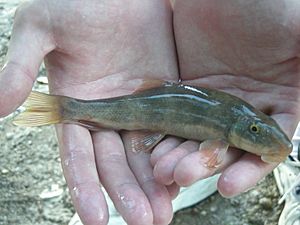Desert sucker facts for kids
Quick facts for kids Desert sucker |
|
|---|---|
 |
|
| Desert sucker, Castostomus clarkii | |
| Conservation status | |
| Scientific classification | |
| Synonyms | |
|
The desert sucker (Catostomus clarkii) is a type of freshwater fish. It belongs to the sucker family. This fish is special because it is found only in certain parts of the United States. You can find it in the Great Basin and the Colorado River Basin.
Desert suckers like to live in fast-moving water. They prefer streams with rocky or gravelly bottoms. This fish has two main colors. Its top part is olive-brown or dark green. Its belly and lower sides are silvery-tan or yellowish. The desert sucker has a round head. Its mouth is on the underside and has thick lips. In Arizona, this fish can grow up to 31 in (79 cm) long. In other places, it is usually about half that size. There are three different types, or subspecies, of the desert sucker. Each lives in a different river area.
Contents
What Does a Desert Sucker Look Like?
Desert suckers have two main colors. Their backs and upper sides are dark. They can be olive-brown to dark green. Their bellies and lower sides are deep-yellow or silvery-tan. The scales on the top half of their bodies have dark spots. These spots form faint dashed lines.
Their head is shaped like a cylinder. It narrows down to a blunt face. The lower lip is about three times thicker than the upper lip. Their mouth is on the underside of their head. It is quite large for the fish. The dorsal fin (the fin on its back) has 10 to 11 rays. Adult desert suckers are usually 4 to 16 inches (100 to 410 mm) long in smaller streams. But they can grow up to 31 inches (790 mm) in Arizona. Their weight can be from 4 to 65 ounces (110–1,840 g).
Where Do Desert Suckers Live?
The desert sucker is found in several states in the United States. These states include Nevada, Utah, Arizona, and New Mexico. This fish lives in the lower Colorado River basin. This is the area below the Grand Canyon. They are often found in the Gila River. They also live above the Grand Canyon. Here, they are found in streams in the Virgin River basin and the White River basin. The total area where desert suckers live is about 128,000 km2 (49,000 sq mi).
What Kind of Home Do They Like?
Desert suckers like water that moves quickly. They prefer rapids and flowing streams. They especially like places with gravelly or rocky bottoms.
How Do Desert Suckers Reproduce?
Desert suckers become adults when they are two years old. They lay their eggs in the winter and spring. This usually happens from January through May.
Different Types of Desert Suckers
Scientists have found three different types, or subspecies, of the desert sucker. These are:
- The White River desert sucker (Catostomus clarkii intermedius).
- The Virgin River desert sucker (Catostomus clarkii utahensis).
- The Meadow Valley Wash desert sucker (Catostomus clarkii - this one does not have a special name yet).
Some fish scientists used to think these fish belonged to a different group called Pantosteus. But now, most scientists think Pantosteus is a smaller group within the Catostomus family. Sometimes, desert suckers (Catostomus clarkii) might even mix with another type of sucker called Catostomus insignis.
See also
 In Spanish: Catostomus clarkii para niños
In Spanish: Catostomus clarkii para niños


